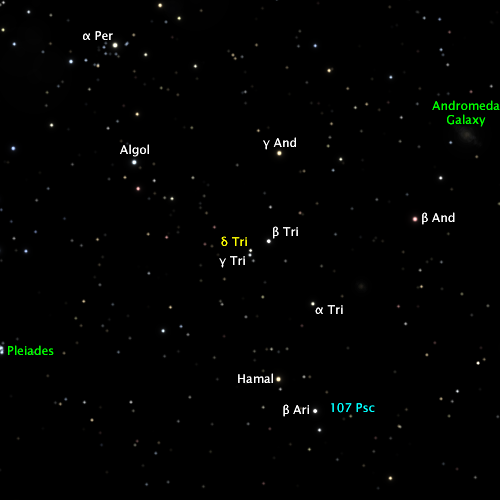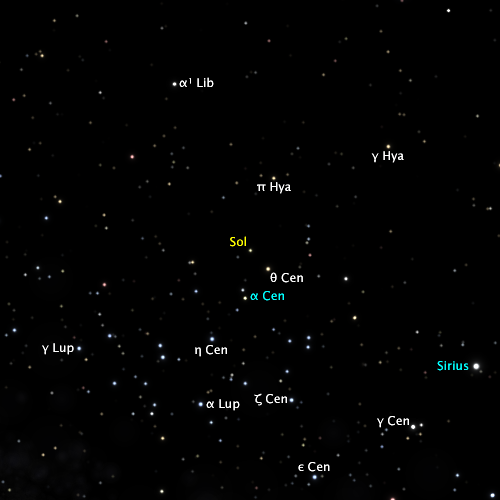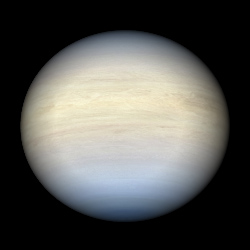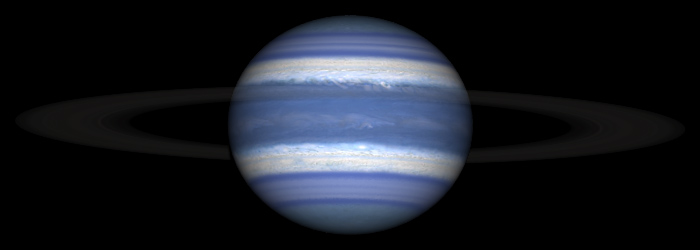
 |
| Right Ascension | 02h 17m | |
|---|---|---|
| Declination | +34° 13' | |
| Distance | 35.29 ± 0.31 ly | |
| Star | Delta Trianguli A | Delta Trianguli B |
| Spectral Class | G1V | G9?V |
| Estimated Mass | 0.95 × Sol | 0.65 × Sol |
| Luminosity | 0.8 × Sol | 0.3 × Sol |
| Delta Trianguli as seen from Sol. |
Sol as seen from Delta Trianguli. |
|---|---|
 |
 |
| Star | Magnitude | Distance |
|---|---|---|
| Alpha Aurigae (Capella) | −1.09 | 25.0 |
| Canopus | −0.55 | 318.4 |
| Aldebaran | −0.06 | 43.3 |
| Rigel | 0.14 | 845.7 |
| Betelgeuse | 0.37 | 479.6 |
| Alpha Arietis (Hamal) | 0.44 | 32.0 |
| Achernar | 0.54 | 144.9 |
| Beta Centauri (Hadar) | 0.78 | 423.9 |
| Beta Arietis (Sharatan) | 0.88 | 26.1 |
| Alpha Crucis (Acrux) | 0.97 | 351.8 |
Delta Trianguli is a binary star system located about 35 light years from Sol. It is a spectroscopic binary: the component stars orbit with a separation of only 0.01 seconds of arc as seen from the Solar system and the binary nature of the system is best shown by Doppler shifts in the spectral lines of the component stars. Because the stars orbit close together, the component stars cannot be resolved by most telescopes.
The spectroscopic nature of the system makes it difficult to determine the mass and luminosity of the individual stars. Fictional but plausible values have been adopted here. These fictional values are based on a total mass of 1.6 suns and a mass ratio of 9:13.
What is known with certainty is the total luminosity of the system, which is about 1.1 times the Sun. A habitable planet orbiting both suns that receives the same amount of light as Earth receives from its sun would have an orbit radius about five percent greater than that of the Earth.
The orbit of both suns about each other has a radius of about 0.106 astronomical units. It is known from numerical simulations that a planet orbiting around a pair of stars in this arrangement needs an orbital separation of about five times the separation of the stars before the orbit is stable. This minimum radius is equal to 0.53 AU for the Delta Trianguli system.
| Destination | Distance |
|---|---|
| 107 Piscium | 13.4 |
| Eta Cassiopeiae A | 20.2 |
The Delta Trianguli system has five planets and three planetoid belts. In order from the suns are the Inner Planetoid Belt, three terrestrial planets (Aldizan, Nessoria and Baalor), the Main Planetoid Belt, two gas giants (Davenant and Manthis) and the Icy Planetoid Belt.
| Planet | SMA (AU) |
Orbital Period |
e | Equatorial Diameter (km) |
Mass (Earths) |
Density (g/cm3) |
Gravity (Earth g) |
Atmospheric Pressure (Earth=1) |
Sidereal Day |
Mean Solar Day |
Axial Tilt |
Known Moons |
|---|---|---|---|---|---|---|---|---|---|---|---|---|
| Aldizan | 0.7479 | 177.68 d | 0.0944 | 5779 | 0.07076 | 4.19 | 0.3446 | 0.000219 | 1d 05h 18.6m | 1d 05h 30.8m | 11° 19.0' | 1 |
| Nessoria | 1.241 | 1.0398 y | 0.0193 | 12100 | 0.8005 | 5.17 | 0.8885 | 1.78 | 1d 02h 42.6m R | 1d 02h 38.0m | 151° 50.7' | 1 |
| Baalor | 1.963 | 2.0683 y | 0.0213 | 9840 | 0.3561 | 4.29 | 0.5981 | 0.213 | 17h 26.7m | 17h 27.7m | 22° 16.2' | 2 |
| Davenant | 8.948 | 20.130 y | 0.1144 | 58610 | 20.72 | 1.29 | 0.9808 | &mdash | 09h 12.5m | 09h 12.5m | 14° 32.3' | 10 |
| Manthis | 30.04 | 123.83 y | 0.2815 | 105700 | 85.07 | 0.919 | 1.238 | &mdash | 16h 00.0m | 16h 00.1m | 41° 40.0' | 14 |
| Name | Diameter (km) |
Period (days) |
Semimajor Axis (km) |
Ecc | Inc |
|---|---|---|---|---|---|
| Natural Satellites of Aldizan | |||||
| Aldizan I | 17 | 1.869 | 26520 | 0.0015 | 0.05 |
| Natural Satellites of Nessoria | |||||
| Nessoria I | 582 | 1.415 | 49430 | 0.0183 | 0.03 |
| Natural Satellites of Baalor | |||||
| Baalor I | 13 | 1.949 | 46730 | 0.0043 | 0.03 |
| Baalor II | 23 | 4.847 | 85760 | 0.0165 | 0.76 |
| Natural Satellites of Davenant | |||||
| Davenant I | 1643 | 0.6273 | 85020 | 0.0002 | 0.03 |
| Davenant III | 1108 | 1.272 | 136200 | 0.0011 | 0.76 |
| Davenant II | 1203 | 3.103 | 246800 | 0.0283 | 0.68 |
| Davenant IV | 464 | 7.952 | 462300 | 0.0134 | 1.04 |
| Davenant V | 229 | 15.88 | 733100 | 0.0291 | 1.97 |
| Davenant VI | 189 | 23.36 | 948200 | 0.0399 | 0.37 |
| Davenant VII | 118 | 31.07 | 1147000 | 0.0394 | 1.02 |
| Davenant VIII | 124 | 46.67 | 1504000 | 0.0402 | 3.12 |
| Davenant X | 57 | 59.78 | 1774000 | 0.0104 | 5.79 |
| Davenant IX | 68 | 90.98 | 2347000 | 0.0675 | 22.75 |
| Natural Satellites of Manthis | |||||
| Manthis V | 340 | 0.6841 | 144200 | 0.0006 | 0.03 |
| Manthis VI | 551 | 1.026 | 189000 | 0.0031 | 0.76 |
| Manthis IV | 930 | 1.490 | 242400 | 0.0015 | 0.11 |
| Manthis VII | 529 | 2.233 | 317400 | 0.0009 | 0.16 |
| Manthis I | 3498 | 7.829 | 732500 | 0.0091 | 1.16 |
| Manthis II | 3921 | 15.66 | 1163000 | 0.0125 | 1.58 |
| Manthis III | 1603 | 23.48 | 1524000 | 0.0316 | 3.59 |
| Manthis VIII | 453 | 39.15 | 2142000 | 0.0308 | 4.12 |
| Manthis IX | 793 | 88.33 | 3685000 | 0.0590 | 3.94 |
| Manthis X | 207 | 134.9 | 4887000 | 0.0714 | 9.27 |
| Manthis XI | 50 | 152.8 | 5310000 | 0.0976 | 11.18 |
| Manthis XIII | 73 | 245.9 | 7293000 | 0.0301 | 13.48 |
| Manthis XII | 55 | 347.1 | 9177000 | 0.1146 | 164.77 |
| Manthis XIV | 26 | 853.8 | 16720000 | 0.2662 | 21.78 |
The Inner Planetoid Belt is an assortment of small bodies sunward of the inner planet, Aldizan. The belt is thinly populated with only a few dozen bodies known.
Aldizan is a heavily-cratered world with a thin atmosphere. It is one of those rare planets that orbits closest to its sun — or suns in this case — yet is not tidally locked. This is a consequence of the system possessing little room for planetary orbits that are far enough from the twin suns to be stable, yet close enough to be within the tidal locking radius. Aldizan’s orbit is well outside the tidal locking radius.
Out of the five planets in the Delta Trianguli system, its orbit is closest to the Inner Planetoid Belt. Its proximity to this Belt causes this world to be heavily cratered and is the likely origin of its small moon.
Nessoria is a terraformable world with a mass about 4⁄5 that of the Earth. Its oceans and seas cover about 64% of the planet’s surface. Its atmosphere is relatively thick compared to that of the Earth, and is a primordial mix of carbon dioxide and nitrogen that is unbreathable for humans.
The most notable feature of Nessoria is its retrograde rotation. Worlds with retrograde rotation have day and night cycles like normal worlds, but the stars appear to rise out of the west from night to night instead of setting.
Nessoria has one small moon in a close orbit.
Baalor is an Marslike world with a thin, unbreathable atmosphere. The world has some potential to sustain terraforming, but is considered to be unsuitable by the Terraforming Committee due to its low surface gravity, thin atmosphere and lack of a planetwide magnetic field.
The Main Planetoid Belt is the densest planetoid belt in this system. It is analogous to the Asteroid Belt in the solar system.
 |
Davenant is a gas giant with a mass about 25 per cent greater than Neptune’s mass. Its appearance is similar to Saturn — without the rings — which is caused by the presence of similar trace compounds in its atmosphere.
 |
Manthis is the largest planet in the Delta Trianguli system. It orbits the twin suns in a large, somewhat eccentric orbit.
In general appearance it is a blue planet, but it has a pair of bright, prominent bands on both sides of the equator that provide contrast with the rest of the planet.
The planet possesses a wide but faint ring of debris.
The Icy Planetoid Belt lies in the cold outer reaches of the Delta Trianguli system. It is composed of icy bodies similar to the Kuiper Belt in the solar system.